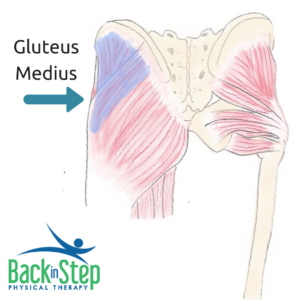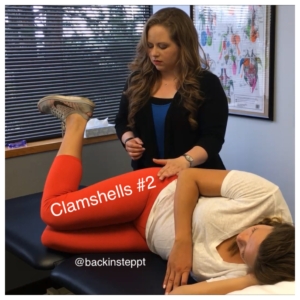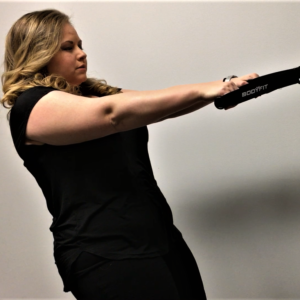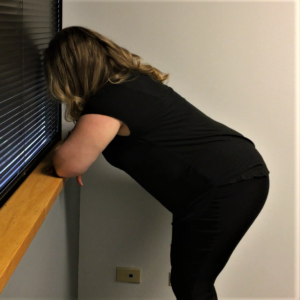Posts
Shoulder or Back Pain? Keep Reading!
/in Exercise Ideas, Uncategorized /by Dr. Alyssa Arms, PT, DPT, OCSWhen you’re experiencing pain in the shoulder or in the back, there are a lot of things that can be contributing to it. An evaluation with a physical therapist can help assess what all is playing a role in your pain. One structure that can be involved with BOTH areas is a large muscle called the latissimus dorsi.
The Anatomy & Function
The latissimus dorsi (lat) spans a large area across the back, originating from various points throughout the pelvis and low back (at the spinous processes of T7-L5, the thoracolumbar fascia, the iliac crest, and inferior 3-4 ribs). It then inserts at the intertubercular groove of the humerus (near the shoulder on the upper arm bone). It is the largest muscle in the upper body. The innervation is from the thoracodorsal nerve (C6-8).

It helps in many different motions or actions, including shoulder extension (moving your arm behind you), shoulder adduction (bringing your arm across your body), and arm internal rotation (rotating your palm towards your body). The lat also assists with several other motions at the shoulder and helps to support and move at the spine.
If the latissimus dorsi isn’t doing its job, it can contribute to arm or shoulder pain, low back pain, decreased range of motion and function of the arm, and more. It can also make it difficult to pull something towards you. Lastly, it can also affect how you can do exercises like pull-ups, lat pull-downs, rows, and deadlifts.
What to Do About It⠀⠀⠀⠀⠀⠀⠀⠀
We’ve got a couple of options to share with you – both a stretch and a strengthening exercise.
Lat Stretch
- Stand with your feet hip width apart or even slighty wider.
- Hold on to the door frame with your thumb pointing up towards the ceiling. Hand should start around chest height.
- Lean your hips back, like you’re trying to squat or sit back in a chair.
- To vary the stretch:
- Place your hand higher or lower on the door frame.
- Before sitting back into the stretch, rotate your body so that you’re facing your arm slightly, or so that your arm crosses slightly in front of your body. Then sit back.
Lat Strengthening
There are several different pieces of gym equipment that can be used for this exercise. However, one of my favorites is the TRX. It adds a dynamic balance component and works the core and hip stabilizers even more than some other options. Here’s how to do it:
- Stand with your feet shoulder width apart.
- Hold on to each of the TRX straps, arms in front of you and straight. Elbows do not need to be locked out in a straight position, however.
- Lean back, keeping your core engaged with spine and pelvis in neutral.
- Pull your hands down by your side, while keeping your body in this plank position.
- Make sure that you don’t let the shoulders hunch or roll forward as you come up to an upright position. Keep your shoulder blades pulled back and down to avoid this compensation!
Try these exercises and let us know how they work for you! They are two ways to try to combat shoulder or back pain. If you still have pain, give us a call and we can help get you back on track.
Do you have other things that you want to learn more about? Check out other blog posts and our Instagram page.
DISCLAIMER: The purpose of this site is to promote understanding of health, wellness, and prevention. The information on this site is not intended/implied to be a substitute for professional medical advice, diagnosis, or treatment. If you are experiencing pain, please see a medical professional.
Keep Your Back Healthy & Pain-Free
/2 Comments/in Exercise Ideas, Uncategorized /by Dr. Alyssa Arms, PT, DPT, OCSAs someone who has personally dealt with back pain, I can appreciate how important it is that my hips stay strong to maintain a healthy back. By having good strength in the hips, some of the extra work and strain can be taken out of the back and can even help decrease the workload on the knees too! These muscles are some of the largest and/or thickest in the body, but we don’t always utilize them in the most efficient ways.
Let’s learn a little bit more about the gluteus maximus, the largest muscle in the back, or posterior section, of the hip. And, of course, we’ll give you a few ways to work this muscle to keep your back healthy.
The Anatomy & Function
The gluteus maximus (glute max) sits at the back of the hip and pelvis. It is the true powerhouse of our lower bodies. It originates from the gluteal surface of the ilium, lumbar fascia, sacrum, and sacrotuberous ligament. The glute max then inserts on the gluteal tuberosity of the femur and iliotibial tract. It gets its nerve supply from the inferior gluteal nerve (L5, S1, S2).
The glute max helps with external rotation and extension (turning your foot outward and moving your leg behind you) of the leg. Because of its connections and location also helps in keeping your torso upward (like coming back up from bending forwards) and can help with abducting the leg (moving the leg to the side).
If you’ve ever dealt with hip, knee, or low back pain, or even feeling like your hamstrings are tight, you may actually need to do some work on the gluteus maximus. Let’s keep your back healthy!
This muscle is important for a wide variety of activities, including:
- getting up & down from a chair,
- going up & down stairs,
- walking or running up/down hills, or navigating more challenging terrain,
- power for squats, jumps, and leaps,
- and more.
What to Do About It
There are a lot of different ways to work the glute max. We’ll talk about a few options, including some squat variations, hip thrusters, and donkey kicks. We’ll also show you how to stretch the glutes, since tightness here affects the back, just like weakness can cause problems.
The Basics
There are a couple of things that we need to consider any time that we are working on the glutes.
First of all, while working the glutes, it can be tempting to let our back do some of the work, which it isn’t necessarily meant to do. One way to combat that is to keep your core engaged. We like to think about gently pulling your bellybutton towards your spine, without flattening your back. It should feel like when you’re trying to fasten that top button of a pair or jeans. 😊
Secondly, our hamstrings also like to help the glute max in doing its job. As you’re working to strengthen the glutes, make sure that you’re feeling more of the effort in the buttocks or back of the hip, not in the hamstrings in the back of the thigh. You can imagine gently squeezing the glutes as you work. Another option is to bend the knee, giving less advantage to the hamstrings.
Squats
There are MANY variations of squats. Here we have a standard squat pictured, using a weight in the hands as a counter-balance. By doing this, it allows you to get your hips further back by counter-acting your body weight. Notice that knees are staying aligned with the toes and feet are pointed straight ahead. Core is engaged and we are squeezing the glutes on the way up and down.
You can do these with a wider stance, single leg, standing on an unsteady surface (BOSU is our favorite), and more.
Hip Thrusters
- Start by lying on your back, knees bent, and feet flat on the floor.
- Keeping core engaged and glutes activated, push your hips up towards the ceiling.
- The goal is to make it a smooth, fluid motion, not jerky.
- Slowly lower yourself back down to your starting position.
We’ve added a little resistance by holding a weight over the pelvis. You can use a kettlebell like we did, a free weight, a barbell, or even use a resistance band. Another option to engage core even more – keep your upper back and shoulders on an exercise bench with feet on the floor. It will allow for a larger range of motion to work the glutes.
Donkey Kicks

Standing Kicks:
This is good if you have more back pain, have difficulty maintaining the hands and knees position, or can only work in a limited range of motion at the hip. This is also a good starting spot if you are new to this sort of exercise.
- Stand about 1-2 feet away from a table, counter, or other sturdy piece of furniture that is at least waist height.
- Lean forward to get your upper body supported on the surface, whether it’s bend elbows as picture or on your hands with straight arms.
- Engage your core.
- Extend one leg behind you while maintaining a neutral spine. Feel as though your heel is driving your leg backwards or like you’re even extending through your heel.
- Slowly lower back down to your starting position.
You can start with a straight leg, which will get both glute max and hamstrings to help with the motion. As it gets easier, work towards doing this with a bent knee, which starts to focus in on the glute max even more.
Make sure that you don’t let your back arch or pelvis twist as you do this!


Quadruped Kicks:
- Start on hands and knees. Your shoulders should be over your hands and your hips should be over your knees.
- Engage your core, keeping your spine straight.
- Extend one leg behind you while maintaining a neutral spine. Feel as though your heel is driving your leg backwards or like you’re even extending through your heel.
- Slowly lower back down to your starting position.
You can start with a straight leg, which will get both glute max and hamstrings to help with the motion. As it gets easier, work towards doing this with a bent knee, which starts to focus in on the glute max even more.
Again, make sure that you don’t let your back arch or pelvis twist as you do this!
Glute Stretch
Tightness in the low back and glutes can also contribute to low back pain, so here’s a way to combat that. We like to use the stretch strap or a belt to help hold the legs in place, so it doesn’t feel like you’re straining your upper body in order to stretch the lower body!
- Lie on your back on the floor.
- Bring one knee up towards your chest and then the other. By moving both at the same time, you may place more stress on your back, especially if you’re already having low back pain.
- Bring your knees towards your chest until you feel a gentle stretch in the low back or buttock.
- Hold for a total of 1-2 minutes.
- To come back out of this position, again move one leg at a time.
Give these exercises a try and let us know how they work for you. Here’s to a healthy back!
Want more exercise ideas? Check out our other blogs and our YouTube channel!
DISCLAIMER: The purpose of this site is to promote understanding of health, wellness, and prevention. The information on this site is not intended/implied to be a substitute for professional medical advice, diagnosis, or treatment. If you are experiencing pain, please see a medical professional.
Strong Hips are Crucial!
/in Exercise Ideas, Uncategorized /by Dr. Alyssa Arms, PT, DPT, OCSThere are many important muscles and other structures to consider in the hips, and it’s important to have strong hips. One that is often neglected or underused is called the gluteus medius.
The Anatomy & Function
This muscle sits at the back of the hip and pelvis, underneath the gluteus maximus. It originates from the gluteal surface of the ilium and inserts onto the greater trochanter of the femur, and gets its nerve supply from the superior gluteal nerve (L4, L5, S1).
The gluteus medius helps in abduction, or moving your leg to the side. It also has a small part in flexion and internal rotation (moving the leg in front of your and turning the leg in) with its anterior fibers, and extension and external rotation (moving the leg behind you and turning the leg out) with its posterior fibers.
When the gluteus medius is working appropriately, it helps to keep your pelvis level when standing on one leg. This also means that it helps with maintaining balance. Lastly, when this muscle is strong, it helps maintain an even workload through your back, hips, and knees. It’s an important player with take off and landing for jumps and leaps. So you can imagine why this is such an important muscle!
What to Do About It
There are MANY ways to work on strengthening and improving the performance of the gluteus medius. Ideally, we get to a point where it’s being worked in a variety of positions and through different movements.
Today, though, we are just talking about a simple place to start. We’ll be working through five different levels of an exercise called Clamshells. Our examples are without any additional resistance added, like a resistance band or ankle weights. To see these exercises in action with a full walk-through, check out our YouTube video here.
Otherwise, keep reading to learn the progression!
The Basics
The starting position is the same for all levels. Start in side-lying with hips stacked on top of one another, knees bent, and fee stacked. Your hips should be bent to about 45* and knees at about 90*.
Some important things to remember:
- Keep your pelvis stable with abdominal muscles engaged.
- Minimize the use of your hands for balance.
- Slow and controlled motion is key.
Level 1
- Feet remain stacked and touching.
- Top knee lifts towards the ceiling, moving into external rotation.
- Hold for 5-10 seconds.
- Slowly lower back down to starting position.
Level 2
- Knees & thighs remain stacked and touching.
- Top foot lifts towards the ceiling, moving the hip into internal rotation.
- Hold for 5-10 seconds.
- Slowly lower back down to starting position.
Level 3
- Hips remain stacked, without rolling or tipping.
- Entire leg stays in slightly bent position, and lifts towards the ceiling, only lifting as high as possible without the spine collapsing towards the floor.
- Hold for 5-10 seconds.
- Slowly lower back down to starting position.
Level 4
- Hips remained stacked, with bellybutton just slightly rolled towards the floor.
- Bottom knee stays on the floor, and feet lift off of the floor.
- From this new starting position, lift the top knee up off of the other leg, while maintaining contact at the feet.
- The top leg then extends to a straight leg, while maintaining the rest of the position.
- Hold for 5-10 seconds.
- Slowly bend knee and reconnect at the feet, then lower back down to starting position.
Level 5
- Position yourself into a side plank, hips without any bend (straight line at hips), knees bent to 90*.
- While maintaining the side plank position and keeping feet stacked, lift top knee towards ceiling.
- Hold for 5-10 seconds.
- Return to side plank position.
Try these exercises out to create strong hips for yourself. Let us know if you have any questions!
DISCLAIMER: The purpose of this site is to promote understanding of health, wellness, and prevention. The information on this site is not intended/implied to be a substitute for professional medical advice, diagnosis, or treatment. If you are experiencing pain, please see a medical professional.
Back In Step Physical Therapy
6551 S Revere Pkwy, Ste 215
Centennial, CO 80111
(303) 960-2075
info@backinsteppt.com







